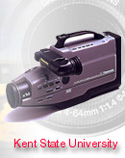

This project has an audio track. You will need to use a headset to keep your audio from disturbing others in the lab.
The purpose of this project is to give you some experience in making simple editing decisions. As you work on this project, you will have to answer these questions:
How do I remove the portions of video I don’t want to use?
Which shots match best with the topics and ideas expressed in different parts of the sound track?
How can I best arrange the shots to provide visual variety and interest for the viewer?
The audio and video for this project were recorded at Angels for Animals, a non-profit all-volunteer animal shelter in the Youngstown, OH area.
Project Directions
Remember, always begin your nonlinear editing work sessions by closing other applications and documents left open by previous computer lab users. Always check that Virtual Memory has been turned off (Apple logo>Control Panel>Memory).
1. Copy the angels folder from your class CD to the computer’s hard drive. Remove your CD.
2. Start Premiere. In the New Project Setting dialog box, choose
- Editing Mode>QuickTime
- Timebase>30
Click Next to display video settings and choose
- Frame Size>240x180
- Frame Rate>15
Click OK to close the dialog box.
Choose File>New>Project.
3. Import the entire contents of the angels folder into this project.
4. Save the project with the name angels.ppj.
5. Arrange the audio files in numerical order on Audio Track 1.
6. Choose a video clip to accompany each audio clip. The video clip should start and end at the same time as the audio clip it goes with. Use the methods you learned in the previous lesson to remove any unwanted video such as extra shots at the beginning or end of a clip, shaky shots, or other mistakes. Make sure that the subject in the shot matches the topic of the audio clip it goes with.
Points to remember:
You can try video clips in different positions. Move or delete a clip in the timeline if it doesn’t work out.
You can make a clip shorter by using only part of it, but you can’t make a clip longer than its original length in the source file.
Save your work often.
7. When your movie is finished, export it with these steps:
Click in the Timeline window to select it.
Choose File>Export>Movie.
In the Export Movie dialog box, click the Settings button.
Choose File Type>QuickTime and Range>Entire Project. Make sure both Export Video and Export Audio are selected.
Click OK to close the Export Movie Settings dialog box.
In the Export Movie dialog box, type angels.mov for the name of the program. Click OK.
8. When the movie is rendered, view it to check for errors. If necessary, make corrections. If the movie is completed the way you want it, save it for grading as follows:
Insert your Zip disk.
Double-click its icon to check the disk’s contents.
Make sure you have at least 45 MB of storage space available on the disk. If not, delete files from the disk by dragging those files to Trash. (Before you do this, make sure these files are ones you don’t mind losing.)
Copy your files angels.ppj and angels.mov to your Zip disk. Make absolutely sure the files have copied correctly.
Remove the Zip disk from the computer.
Check to see that you have labeled both the disk and its case with your name. Turn it in for grading.
9. Finish your lab session as follows:
Quit the Premiere program.
Drag the angels folder from the hard drive to the Trash.
Empty the Trash.
This step permanently eliminates the work you have done this session, so it’s important to perform the step of saving to the Zip disk accurately.Put the computer into the sleep mode.
Home Page | Assignments | Syllabus | Instructor | JMC Web Site